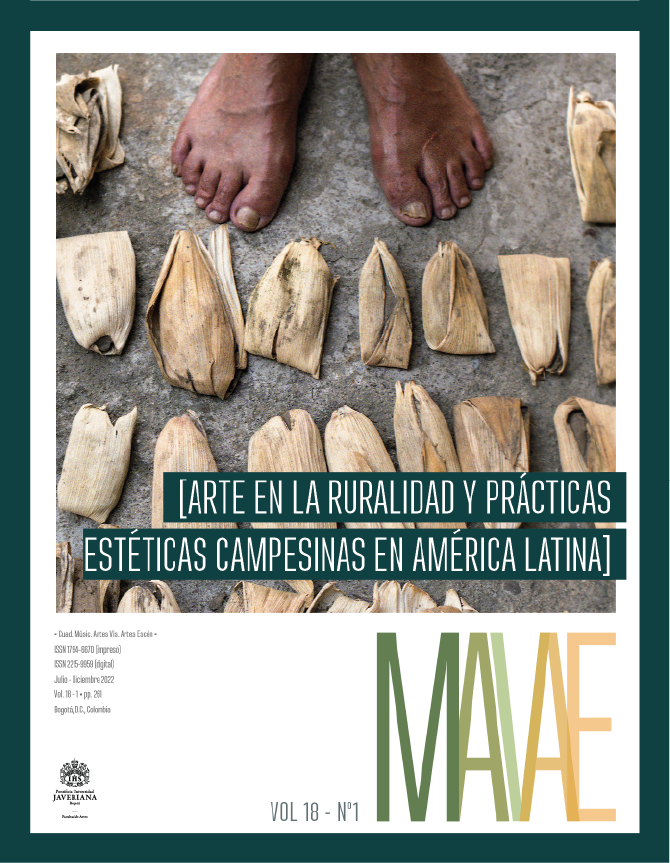Abstract
When it comes to address the bullerengue nowadays, there is a need to rethink some of the standardized ideas of what we understand as “ancestral”, “authentic” or “folkloric”. As all the practices in the Colombian Caribbean Coast, this one has un- dergone many modifications in order to become adapted to the present times, which arises some reflections on the concept Tradition. Therefore, this article aims to do a reflection on the primitive processes that produce sociability regarding the bulleren- gue in Maria La Baja (Bolivar Province), in the light of the concept of folklorism. The methodology herein consists in the biographic analysis of some newest publications as well as the assessment of different testimonials and a personal communication with Wilman Orozco, a prominent character of the bullerengue music in this region. This work allowed drawing the conclusions that the bullerengue in Maria La Baja is an “ancestral” representation that goes beyond the debate about the traditional as something pure and unaltered and is, instead, a folklorist reproduction that the people construct based on accounts of those who construct the bullerengue itself. Due to the foregoing, this article provides a different way regarding what we already know about the bullerengue in Maria La Baja as a product derived from the concept of Folklore. This opened the door towards a not very new assumption, even though it has been scarcely used in relation to the meaning of the transformation processes of the musical traditions in the Bolívar Province and the whole Caribbean Coast.
Bermúdez, Egberto. 1996. “La música campesina y popular de Colombia,1880-1930”. Gaceta 32, n.o 32: 113-20.
Díaz, Francy, Giselle Ponce y Elizabeth Suarique. 2016. “En el centro de la rueda: Cumbia, samba y capoeira”. Huellas: Revista de la Universidad
del Norte, n.o 100: 20-31.
Domínguez Acosta, Gustavo. 2021. “La música como ritual en las fiestas tradicionales del departamento de Bolívar: Identidad, memoria y
significados de la Semana Santa de Mompox y las corralejas de San Juan Nepomuceno”. Cuadernos de Música, Artes Visuales y Artes
Escénicas 16, n.o 1: 104-23. https://doi.org/10.11144/javeriana.mavae16-1.lmcr
Flórez Bolívar, Francisco J. 2008. “Representaciones del Caribe colombiano en el marco de los debates sobre la degeneración de las razas:
Geografía, raza y nación a comienzos del siglo XX”. Historia y Espacio,n.o 313: 5-59. https://historiayespacio.univalle.edu.co/index.php/ historia_y_espacio/article/view/1682/1788
Flórez Forero, Nubia. 2015. “El fandango como espacio de resistencia, creación y libertad”. Música Oral del Sur: Revista Internacional 12:
-402. http://www.centrodedocumentacionmusicaldeandalucia. es/ojs/index.php/mos/article/view/208/14-forero
Gil Calvo, Enrique. 1991. Estado de fiesta: Feria, foro, corte y circo. Madrid:Espasa Calpe.
Hobsbawm, Eric. 1999. “Inventando tradiciones”. Bitarte: Revista cuatrimestral de humanidades, n.o 18: 39-53.
Lemoine, Lizette y Jaime Andrés Salazar. 2013. “¡Ay Petronita, la vida vale la pena! Semblanza de la cantadora Petrona Martínez”. Nómadas 39:
-2228. http://www.scielo.org.co/pdf/noma/n39/n39a15.pdf
Martí i Pérez, Josep. 1996. El folklorismo: Uso y abuso de la tradición.Barcelona: Ronsel.
Martí i Pérez, Josep, ed. 2008. Fiesta y ciudad: pluriculturalidad e integración. Madrid: Consejo Superior de Investigaciones Científicas.
Ochoa, Juan Sebastián. 2016. “La cumbia en Colombia: Invención de una tradición”. Revista Musical Chilena 70, n.o 226: 31-52. https://doi.
org/10.4067/S0716-27902016000200002.
Ochoa-Escobar, Federico y Nathaly Gómez-Gómez. 2019. “‘Se busca el bullerengue’: Concordancias y afectaciones del concepto folclor en
las prácticas culturales locales”. Revista Colombiana de Pensamiento Estético e Historia del Arte 10: 121-166. https://revistas.unal.edu.co/index.php/estetica/article/view/91795/77174
Pérez Herrera, Antonio. 2014. “El bullerengue: La génesis de la música de la Costa Caribe colombiana”. El artista: Revista de investigaciones en
música y artes plásticas, n.º 11: 30-52. https://biblat.unam.mx/hevila/Elartista/2014/no11/2.pdf
Pérez Herrera, Antonio. 2006. “La música son de negro y son de pajarito, punto de convergencia de la cultura tradicional y la oralidad de
las comunidades del bajo Magdalena”. El artista: Revista de investigaciones en música y artes plásticas, n.o 3: 108-31. https://
biblat.unam.mx/hevila/Elartista/2006/no3/8.pdf
Posada, Consuelo. 1999. “Versos y fiestas en el Caribe colombiano”.Caravelle, n.o 73: 187-200.
Rech, Liz. 2019. “Performing Citizenship: Gathering (in the) Movement”.En Performing Citizenship: Bodies, Agencies, Limitations, editado
por Paula Hildebrandt, Kerstin Evert, Sibylle Peters, Mirjam Schaub, Kathrin Wildner y Gesa Ziemer, 57-75. Cham: Springer.https://doi.org/10.1007/978-3-319-97502-3_5
Rojas, Juan Sebastián. 2012. “‘Me siento orgullosa de ser negra y ¡que viva el bullerengue!’: Identidad étnica en una nación multicultural. El caso del Festival Nacional del Bullerengue en Puerto Escondido, Colombia”. Cuadernos de Música, Artes Visuales y Artes Escénicas 7, n.º 2: 139-157. https://doi.org/10.11144/Javeriana.mavae7-2.msos
Turner, Victor. 1988. The Anthropology of Performance. Nueva York:PAJ Publications.
Wade, Peter. 2002. Música, raza y nación: Música tropical en Colombia.Bogotá: Vicepresidencia de la República.
This journal is registered under a Creative Commons Attribution 4.0 International Public License. Thus, this work may be reproduced, distributed, and publicly shared in digital format, as long as the names of the authors and Pontificia Universidad Javeriana are acknowledged. Others are allowed to quote, adapt, transform, auto-archive, republish, and create based on this material, for any purpose, provided the authorship is duly acknowledged, a link to the original work is provided, and it is specified if changes have been made. Pontificia Universidad Javeriana does not hold the rights of published works and the authors are solely responsible for the contents of their works; they keep the moral, intellectual, privacy, and publicity rights.
Approving the intervention of the work (review, copy-editing, translation, layout) and the following outreach, are granted through an use license and not through an assignment of rights. This means the journal and Pontificia Universidad Javeriana cannot be held responsible for any ethical malpractice by the authors. As a consequence of the protection granted by the use license, the journal is able to publish retractions or to correct information already published. Publishing contents in this journal does not generate royalties for contributors.


